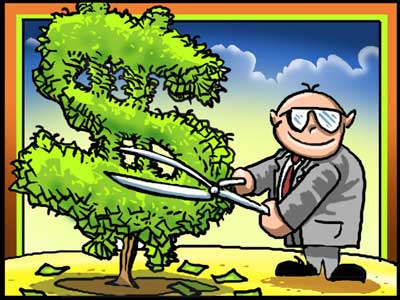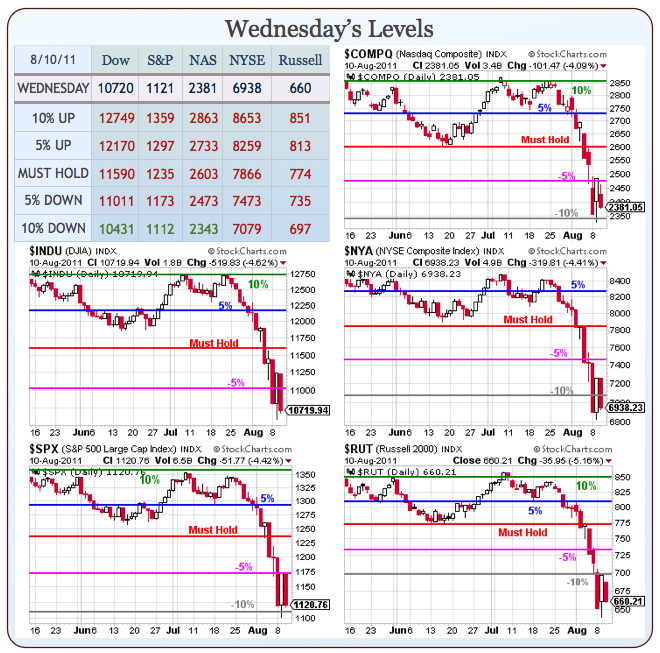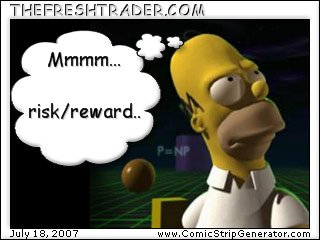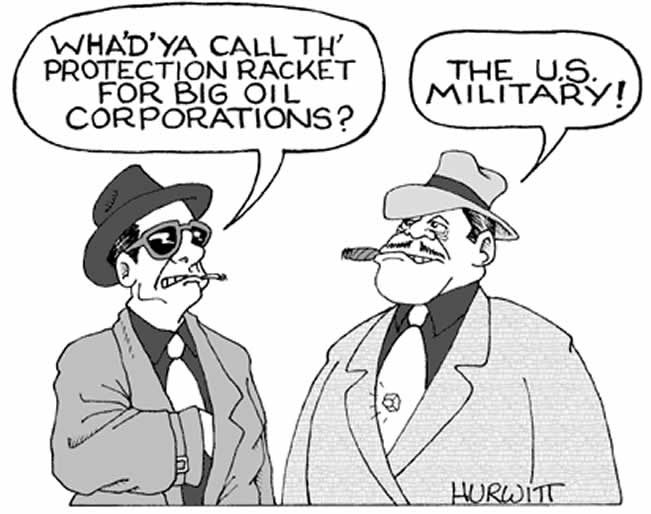 We took our last round of disaster protection back in early July and almost all of those trades are well in the money.
We took our last round of disaster protection back in early July and almost all of those trades are well in the money.
Since you know I am a big fan of taking cash off the table in either direction, let’s not be greedy and look at ways to "roll" our downside protection into new downside plays so we can set SENSIBLE stops on our now deep in the money short plays (very similar to our Mattress Strategy). Keep in mind that this is the biggest market decline we’ve had since last Summer, so adding a layer of protection here doubles our returns if this is the first leg of a major sell-off, or it gives us a smaller hedge that we can roll up later while we take our bigger hedges off the table. As I have to say WAY too often to members – It’s not a profit until you cash it in!
Hedging for disaster is a concept I advocated during another "recovery," in October of 2008, where we made our cover plays to carry us through a worrisome holiday season and into Q1 earnings – "just in case." That "just in case" saved a lot of virtual portfolios! The idea of disaster hedges high return ETFs that will give you 3-5x returns in a major downturn. That way, 10% allocated of your virtual portfolio to protection can turn into 30-50% on a dip, giving you some much-needed cash right when there is a good buying opportunity. At the time, I advocated SKF Jan $100s at $19. SKF hit $300 around Thanksgiving and those calls made a profit of over $280 (1,400%), so putting even just 5% of your virtual portfolio into that financial hedge would give you back 75% of your virtual portfolio when you cash out.
Keep in mind these are INSURANCE plays – you expect to LOSE, not win but, if you need to ride out a lot of bullish positions through an uncertain period, this is a pretty good way to go. We cashed out our bullish $25KP positions by July 28th, (our active virtual portfolio) with the S&P at 1,340 and, since then, I’ve had a very hard time making long-term bullish picks. I want top put up a Buy List but it’s still too risky – this will be step 1 though – protect first, then buy! Once we cash out our bullish short-term holdings (and 75% of your virtual portfolio is in sensible, well-hedged long-term plays, right?) that leaves us with our smaller short-term virtual portfolio and our disaster hedges. Since the disaster hedges were designed to protect 75% of our virtual portfolio that’s now back to cash – that left us pretty bearish overall.

At this point, we are very likely in the capitulation/depression area of the curve BUT it is possible that we’re in DENIAL and things are worse than we think. I’ve already moved on to hope this morning and I haven’t given up yet but we do need to be prepared for a larger breakdown – hence these trade ideas.
On the whole, we haven’t been very bullish since the end of April, when the S&P topped out at 1,370. Our last bullish virtual portfolio (the $25,000 virtual portfolio is opportunistic) was the Feb 5th "Breakout Defense" List and in May we rolled our Secret Santa Inflation Hedges into May Flowering Inflation Hedges but those were a mixed bag. Interestingly, one that worked well was a bullish trade on gold – interesting because everyone thinks I hate gold but here was the trade in May:
We looked at one gold hedge on Monday and another simple one you can do as a long-term gold play is the GLD 2013 $150/200 bull call spread at $13, selling the $130 puts at $8.20 for net $4.80 on the $50 spread with a nice 941% of upside if gold hits $2,000 and holds it through 2013. So the real question for a gold bug is: How much are you willing to lose if you are wrong? Assuming you don’t REALLY want to own gold at $1,300 an ounce if it’s below $1,300 an ounce, how much of a risk were you willing to take on gold in the first place?
If you were considering allocating 5% of a $250,000 virtual portfolio ($12,500) to gold as a hedge against inflation, we can assume you didn’t intend to ride gold down to zero but, of course you were going to stick it out for a 20% loss ($2,500) so let’s call that our risk tolerance and structure the play to make that a 50% loss on the position so we’re talking about a 10 contract spread at net $4,800 that will cost us $2,400 if gold moves against us. The delta on the short puts is .25 so our cushion on this trade is only about $10 on GLD going down so let’s say $1,400 with this structure so you have to be pretty bullish on gold but the upside is a nice $45,200 at GLD $200 which would be an 18% pop to a $250,000 virtual portfolio.
As of today’s close, the 2013 $150/200 bull call spread is $20.40 and the short $130 puts are $4.90 for net $15.50, so up just 223% so far (out of 941% possible) but that’s still a nice $10,600 gain on 10 contracts, which is about as much as you would have made if you had bought 20 ounces of gold for $1,300 ($26,000) and rode them to $1,800. As time moves on, if gold stays high, this position will get better and better.
We did If you have been following our main moves, which were cashing out at the end of July and rolling up the disaster hedges while having fun with our cashy short-term trading, then you should be THRILLED just to cash out the existing disaster hedges with a small profit. This is like having car insurance and, at the end of the year when you don’t have an accident, you get to sell your insurance policy back for a profit! Cash is still king and we haven’t found things to buy yet so there’s not much to protect. So don’t take these plays out of context – they are there to protect our bottom fishing, which we haven’t started yet and they are there to roll out of our successful plays as we take some bearish cash off the table.
I would urge you to read the original Disaster Hedge post to get an idea of our mindset at the time, where I said:
As far as hedging goes, if you are 50% invested and 50% in cash and you are worried about losing 20% on the stock side in a major sell-off, then the logic of these hedges is to take 40% of your cash (20% of your total) and put it on something that may double while the other positions lose. If things go down, your gains on the hedge offset some of the losses on your longer positions. If things go up, you can stop out with a 25% loss, which will "only" be a 5% hit on your total virtual portfolio but it means we are breaking through resistance and your upside bets are safe and doing well. That is not a bad trade-off for insurance in this crazy market. Also, be aware that these are thinly traded contracts with wide bid/ask spreads and you need to use caution establishing and exiting positions.

As we are now, we were very keyed on watching the top of last summer’s range for support, which were at the time: Dow at 10,650, S&P 1,120, Nasdaq at 2,300, NYSE 7,000 and Russell 666. These are all pathetic levels but things can get far worse if we have another crisis of confidence, as we did in 2008-2009. We’ve been looking for a bottom based on Fundamentals and that’s our 10% down lines but sentiment can take us much lower and, as I’ve been saying all week – it’s just too early to bargain hunt because that was a mistake we made in 2008 – looking for floors that never came!
We had a very happy Spring and Summer last year as we ran hedges that prepared us for the crash (see April 28 2010 – "Hedging for Disaster") the same way so that is the goal of our new protectors. Keep in mind, though, these are 2nd stage hedges this time and we do believe the Fed will step in but, just in case they do not, here’s a few ideas to help ride out a larger downturn as well as to protect our eventual buys:
- DXD Oct $23 calls at $2, selling Oct $27 calls for $1.15 and selling Oct $19 puts for .70. This is a net .15 entry on a $4 spread so your upside is 2,566% at $27 (DXD is now $22.15). If the Dow ends up holding 10,650 and moves back up, there’s a good chance you can kill this cover with a small loss as a $3 move on DXD is 15% and that would be about a 7% move up in the Dow to 11,450 before the put you sold becomes a problem. Under 10,500 you stand an excellent chance of at least getting your money back, which makes this very cheap insurance!
- FAZ Oct $65 calls at $22, selling Oct $72 calls for $20 and selling JPM 2013 $20 puts for $2.05 puts for a net .05 credit on the $7 spread (14,000% upside at $72 with FAS now $72!). This one is risky as you can end up owning JPM for net $19.95 but it’s currently trading at $34.37 so that’s a 41.8% discount off the current price on a bank that is HOPEFULLY too big to fail The nice thing about trades like this is it’s VERY UNLIKELY both sides fail on you.
When you are entering a trade like this, assume you will have JPM put to you at $19.95 and allocate how much you are REALLY willing to own. Say that’s $19,500, which would be 1,000 shares and that means you can make this trade with 10 contracts at a net credit of $50 plus (according to TOS) $2,030 in margin. This play returns $7,000 if FAZ simply stays flat and holds $72 through Oct expiration. This hedge then, protects $70,000 worth of existing financial positions against a 10% loss for free (hopefully, you already have buy/writes that protect you from a 20% drop, so we’re good for 30% total) – plus some margin you’d better have laying around anyway!
- SDS Sept $26 calls at $3.20, selling Sept $32 calls for $1.65 and selling VLO Jan $15 puts for $1.20. Here we are in a $6 spread for net .45 with the possibility of making $5.55 (1,233%) if SDS hits $32 (up $5.50 or 20% or down 10% on the S&P to 1,008). We may have VLO put to us for net $15.45 at that level (now $19.26 so 19.7% off). Of course, we can roll the puts down to 2013 and spend .65 of our $5.55 to move the VLO puts to the 2013 $10s (now $1) – which is a pretty good entry on VLO! Remember, the premise is that it’s not likely to have VLO go to $15, let alone $10 if the S&P is rising so your expected cost of insurance is that .45 – although you can stop the bull call spread out long before that happens. If you are willing to own $20,000 worth of VLO at around $10 in 2013, it’s reasonable to take 20 of these hedges, which return $12,000 if the S&P falls 10%. The margin on 20 short VLO Jan $15 puts is just $3,000 according to TOS.
 Another nice thing about this trade, in a vacuum, is that – IF we have a catastrophic failure that forces you to buy 2,000 shares of VLO for $10 – there’s a pretty good chance you will have collected that $12,000 from the SDS spread and that means you are buying 2,000 shares of VLO for net $8,450 – just $4.23 per share!
Another nice thing about this trade, in a vacuum, is that – IF we have a catastrophic failure that forces you to buy 2,000 shares of VLO for $10 – there’s a pretty good chance you will have collected that $12,000 from the SDS spread and that means you are buying 2,000 shares of VLO for net $8,450 – just $4.23 per share!
Another way to hedge SDS if you are not margin constrained is by selling SPY puts. SPY Sept $98 puts are $1.80 so a net .15 credit against the above spread and you KNOW the puts are rollable and, of course, the SPY puts CAN’T go in the money until AFTER you make $6 per spread. What you are playing for here is that the S&P will drop 10% but not 15% (and, assuming a roll, 20%).
I’m sure some of our more savvy traders have already realized that once SPY drops 10%, we can simply add more hedges and at 15%, more hedges and at 20%, even more hedges to protect against getting too burned on the short puts. Layering in our Disaster Hedges is always a good plan. After all, that’s what these hedges are as we’ve already got plenty of hedges like this from when the market was 15% higher!
The great thing about this kind of play is that, if the S&P goes up, the insurance is free as the short puts expire worthless. You can even stop out the $1.65 hedge at around .80 and you end up with something in your pocket as a reward for all your hard work.
 Keep in mind that this is insurance, not betting. These are hedges that are meant to perform for you if your upside bets don’t work out and will hopefully not cost you too much money when your upside plays go well. If your upside plays are sensibly hedged, like our buy/writes that pay at least 10% a quarter in a flat to up market, then this kind of sensible insurance is all you should need to offset reasonable dips in the market. It doesn’t mean you don’t need stops.
Keep in mind that this is insurance, not betting. These are hedges that are meant to perform for you if your upside bets don’t work out and will hopefully not cost you too much money when your upside plays go well. If your upside plays are sensibly hedged, like our buy/writes that pay at least 10% a quarter in a flat to up market, then this kind of sensible insurance is all you should need to offset reasonable dips in the market. It doesn’t mean you don’t need stops.
Now let’s finish up with a specific disaster hedges on the things we are worried about. As a hedge against inflation, some people like gold. I am not a fan of gold as I think it’s overpriced but it does have it’s uses and I wrote a post on hedging into gold back in March of last year so maybe it’s time for an update. As a hedge against many other things, including inflation, I prefer TBT, who I may have mentioned at some point. If there is inflation, then the cost of lending and borrowing money will rise as the lender knows that they will get paid back in dollars that are worth less (worthless?).
This is why I don’t buy into a commodity rally when the cost of capital is low – clearly the lenders don’t believe rising costs are a long-term factor if they will give you money for 30 years at 5%. Land is a commodity. Copper and wood and even the labor that goes into building your home is a commodity so if gold is a true "hedge" against inflation and gold is up 50% in two years – then we should expect similar appreciation from a home and the banks that are lending Trillions of Dollars at a mere 5% are fools. Maybe they are – maybe gold is a little ahead of itself…
- TBT is a simple bet, we don’t think rates will go lower. Over the past 12 months rates have stayed down around 0-0.25% on the Fed and TBT has gone from a low of $24.80 (yesterday) to a high of $41.54 (January) but, on the whole, has gone nowhere at all in 12 months. That would suit us just fine if we sell the Jan $22 puts for $1.55 with $6.50 in net margin for our troubles. With $1.55 in hand there is no need to be greedy so we can buy the Jan $28 calls for $1.80 to make a .25 spread. Last August, TBT ran from $29.77 to $40 before the end of the year. A run back to just $35 from here would put those calls $7 in the money – up 2,800%. Selling 10 of the Jan puts for $1,550 plus $25 of your own cash can lead to $7,000 of protection against a rise in rates (great hedge for bond-holders). Keep in mind though, that the Fed has said rates will stay low through 2013 so it would be wise to uses stops on the puts, at least, if TBT fails to hold $24!
- EDZ is my other universal hedge. It’s a 3x inverse to the MSCI Emerging Markets Index which is BRIC-weighted but also includes Africa, Eastern Europe, the Middle East and Latin America so our bet is that something goes wrong somewhere in the world sometime. With EDZ now at $27.78, the Jan $75 calls are very overpriced at $3 and can be sold short, especially since you can buy 2 Jan $25/40 bull call spread for $2.60 each. Paying net $2.20 for this spread is not at all terrible as it makes net $27.80 (1,263%) long before the short calls are in the money and, of course, you can set a stop on the short calls at $5 as this hedge is already $2.78 in the money ($5.56 on 2x) so you KNOW you are making money on the Bull Spread if you are losing it on the short puts! Margin on the sale of the naked calls looks like $8 but that should be offset somewhat by your long positions. EDZ hasn’t been over $75 since late 2009 but it can go VERY high VERY quickly so take those stops seriously or use another offset. Figure a 10% drop in the markets in a day (unlikely) could pop EDZ 30%, which would be about $9 and the delta on the Jan $75s is .29 so maybe they go up $3-4 and you have to buy them out for $7. As EDZ would be at $36+ and the 2 spreads would be $11 in the money – that’s not so terrible, is it?
 As with all of our protection plays, if we become more confident that the market will NOT collapse, then we simply take them off the table with a small loss and that makes us more bullish but having a few hedges like this in your virtual portfolio can do a lot to cushion the blows from any major market sell-offs.
As with all of our protection plays, if we become more confident that the market will NOT collapse, then we simply take them off the table with a small loss and that makes us more bullish but having a few hedges like this in your virtual portfolio can do a lot to cushion the blows from any major market sell-offs.
I cannot remind you enough though that these are insurance plays and they are not ideal for rolling or adjusting and you should EXPECT to lose money if the market heads higher – much the same as you expect to have "wasted" your life insurance premium for the prior year every time you celebrate another birthday….
As with life insurance, it may make you feel good to walk around with $50M worth of protection in case you get hit by a bus but – is it realistic? Look at your virtual portfolio and think about what kind of protection you REALLY need. If you have $100,000 worth of May buy/writes that are good for a roughly 15% dip in the market, then you don’t really need ANY protection against a 15% drop. If the market drops 25%, then you will lose 10% on what you have now. If the market drops 40%, then you lose 25%. We all learned how valuable it can be to simply stay even in a major market drop as opportunities abound then so simply putting 5% away on hedges that will pay 25% back when the market drops 40% will let you cash out with 100% of what you have now and go shopping – that’s all insurance needs to do.
Disaster hedges are a good exercise in managing your virtual portfolio but, unfortunately, like Auto insurance, you just pay and pay and pay until you have that accident. So safe driving!



